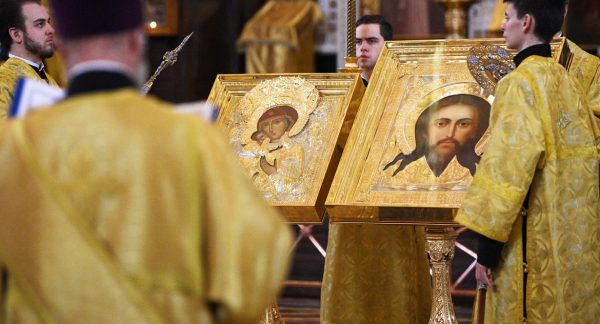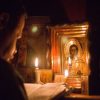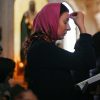The Reading from the Holy Gospel according to St. John. (1:43-51)
One day as I finished the liturgy a man approached me with a rather odd question: “Is all of this necessary?” By “all of this” he meant, the liturgy, the priestly vestments, the icons in the church and so forth and so on. He was a charismatic evangelical and there is no doubt that for him this was all over the top. At the time I looked at him and paused for a moment and said “This is precisely what has been handed down to us and for us this is sacred. We have no reason to change it.”
I’ve thought about that question quite often, “Is all of this necessary.” In fact the short answer is “Yes”. The life of the Orthodox Church is not random or according to the whims of a couple of leaders. It is built upon layers of theology and meaning and history that present themselves during and through our life of worship. Our life of worship must be beautiful and the place that we come to pray must also be beautiful. Why? Because God is the creator of beauty and order and He expects us to treat His whole creation and the space we are given in an orderly and beautiful way. This is not only true for the church sanctuary, it is also true with our lives. The life of a Christian should be well ordered and not full of chaos. Regarding the beauty of the Church, God has given us our senses in order that we might admire beauty and be filled with awe and reverence for Him. The senses were given to us in order to help us draw nearer to God. But the things we do in the church are no mere decorations. No. They have meaning and purpose and that purpose must not contradict the teachings given by the Lord Himself. God gave instructions to Moses for the setting up of the tabernacle and the altar and the priestly vestments. He is a God of order and beauty. If God did not deeply care about these matters He would not have instructed such things. Yet, there is something more to “all of this” especially when it comes to holy iconography.
On the first Sunday of Great Lent, in every Eastern Orthodox church around the world, this day is celebrated as the Sunday of Orthodoxy or the “Triumph of Orthodoxy”. It commemorates a very specific event, namely the return of the holy icons to the all of the churches. The victory of the icons was won at the seventh ecumenical council held in the city of Nicaea in 787 ad. It was convened because a great controversy had taken place regarding the role of icons in the churches.
There were some Christians who believed that making and veneration of icons was forbidden by God in the Old Testament and even in the ten commandments. There were yet others who were influenced by Islam to say that icons were a form of blasphemy against God. The Church heard all of these things and these teachings spread far and wide. However the holy fathers of the 7th ecumenical council came together with the guidance of the Holy Spirit to pray, to reason from the Scriptures and to expound on the apostolic faith that was delivered to the Church once and for all.
What was their verdict? That icons must be restored in all of the churches. Why? Because Jesus Christ, the Son of God, became a man. He really existed. People saw Him and in seeing Him they actually saw God! Where do we get such a revolutionary idea? We get it from Jesus Himself when He says “He who has seen me, has seen the Father who sent Me.” Our Lord also says “I and the Father are one.” St. Paul also affirms the teaching of the seventh council when he writes “Christ is the image of the invisible God.” In fact in Greek the great apostle to the gentiles actually says “Christ is the IKON of the invisible God.” It is a bold statement! We are affirming that the Lord Jesus Christ actually took flesh and became man and dwelt with His people and because He was seen, touched and heard, we are able to depict Him because God has in fact been seen in the Son of God, Our Lord Jesus Christ.
While we depict Him and His Holy Mother and all of the saints in icons, we do not worship the icons. They are aides to our prayer. Our love and veneration passes from the image to the ones who are depicted in the image. Many of you have photographs of your loved ones and children, but you don’t worship those photos. You love the people who are in the photos and the photos remind you of them and bring to your heart a powerful feeling of being connected. They are an aid to loving them.
The Church tells us that in fact icons are necessary and good. They help us to pray and anything that helps us to pray deeply and genuinely is good. It must be so, because prayer brings us to God and this is the goal and purpose of our lives as Christians, to know God intimately, not as an abstraction. God cannot be an abstraction for us because He lived among us and became one of us. He has taken on our nature in order to share His divine nature with each of us. God became man, in order to make each of us His true sons and daughters. But you shouldn’t merely take my word or the word of your parents or others. We have to be like Nathaniel who took the words of Philip seriously. And what were these words? “Come and see.” Lent for us is a reminder that you will never know God intimately unless you take seriously these words “come and see”. Let us not go through the motions but honor the God who was seen and heard and touched. Let us live as if He exists and let us chase Him down.
How can we chase Him down? How can we live as if He exists? By helping the poor and the needy and sick. By honoring His body (which is the Church) and attending the prayers, making them a priority in our lives. By making the holy sacraments an important part of our lives. Not just holy communion but also confession. These things are given to you by God, to help you and comfort you and heal you. We can also chase God down through other activities. They are not surprises at this point, you have heard them mentioned quite often. We chase God by studying the gospels and the Scriptures as if they are the most important writings in the history of the world (they are). We chase God by finding quality quiet time for God, at least every morning and every evening for some time. We chase God by offering kindness to others, and striving to live like saints.
This is our holy task as Orthodox Christians, to be like the saints and to chase God. What all of the saints realize when they earnestly apply themselves to this task is that in fact, God has been chasing them all along. The proof is that the Son of God became a man, precisely for this reason. To capture our minds and hearts with His love. The icons in the churches help us to remember all of this and they invite us on a daily basis to “come and see.” May our lenten journey be a serious effort to follow in the footsteps of the disciple Nathaniel and “come and see.” And Glory be to God forever AMEN.

















